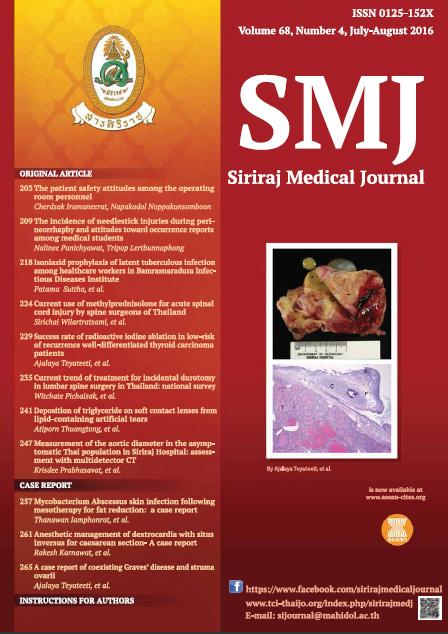Measurement of the Aortic Diameter in the Asymptomatic Thai Population in Siriraj Hospital: Assessment with Multidetector CT
Keywords:
Aortic diameter, measurement, multi-detector CTAbstract
Objective: The purpose of this study was to determine normal reference values of intra-thoracic and abdominal aortic diameters of asymptomatic Thai adults obtained by multidetector computed tomography. Secondary end points were evaluation of relationships between aortic diameters and patients' demographic data or potential risk factors of cardiovascular disease.
Methods:Three hundred and ten Thai adults in Siriraj Hospital who had no any signs or symptoms of cardiovascular disease that examined with computed tomography (CT) of chest and whole abdomen were investigated in this study. Aortic diameters were measured at eight predefined intra-thoracic and abdominal levels on CT images, including ascending aorta, proximal transverse aortic arch, distal transverse aortic arch, aortic isthmus, thoracoabdominal junction, celiac axis, suprarenal aorta and aortic bifurcation. Analysis of data was performed with regard to patients' demographic data (age, sex, weight, and height) and three potential risk factors of cardiovascular disease (hypertension, dyslipidemia and diabetes mellitus). Furthermore, we also recorded the co-morbid non-cardiovascular underlying diseases which were classified into seven groups, including tumors (malignant and benign tumors), infectious diseases, inflammatory diseases, autoimmune diseases, degenerative diseases, psychiatric diseases and others.
Results:Aortic diameters were 3.14±0.40 cm. at the ascending aorta, 2.88 ± 0.34 cm. at proximal transverse aortic arch, 2.65±0.30 cm. at distal transverse aortic arch, 2.46+ 0.31cm. at aortic isthmus, 2.10± 0.27 cm. at thoracoabdominal junction, 1.99 ± 0.26 cm. at celiac axis, 1.81 ±0.25 cm. at suprarenal aorta, and 1.47±0.21 cm. at aortic bifurcation. Overall aortic diameters tend to continuously significantly decrease aortic diameters from proximal to distal direction from ascending aorta to aortic bifurcation. Men had slightly more enlarged aortic diameters in all eight predefined levels than women with statistical significance (p<0.05). Increasing age is an independent and the most influential predictor of increasing size of aortic diameter in all aortic levels. Furthermore, age was classified into three age groups; 18-50 years, 51-70 years and 71-94 years. There were significant differences of aortic diameter in all aortic levels, except two age groups which are 51-70 years and 71-90 years when considered at celiac trunk and aortic bifurcation levels. Aortic diameters increased as weight increased at only one aortic level which was aortic bifurcation, with statistical significance (p<0.001). Weight was an independent influential predictor of aortic diameter in various levels, which were 5-46 percentages of influent degree. All aortic diameters were not increased with underlying hypertension, dyslipidemia and diabetes mellitus.
Conclusion: This study delineates normal intra-thoracic and abdominal aortic diameters, including relationships with age and sex in asymptomatic Thai adults.
Downloads
Published
How to Cite
Issue
Section
License
Authors who publish with this journal agree to the following conditions:
Copyright Transfer
In submitting a manuscript, the authors acknowledge that the work will become the copyrighted property of Siriraj Medical Journal upon publication.
License
Articles are licensed under a Creative Commons Attribution-NonCommercial-NoDerivatives 4.0 International License (CC BY-NC-ND 4.0). This license allows for the sharing of the work for non-commercial purposes with proper attribution to the authors and the journal. However, it does not permit modifications or the creation of derivative works.
Sharing and Access
Authors are encouraged to share their article on their personal or institutional websites and through other non-commercial platforms. Doing so can increase readership and citations.











